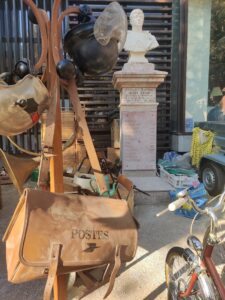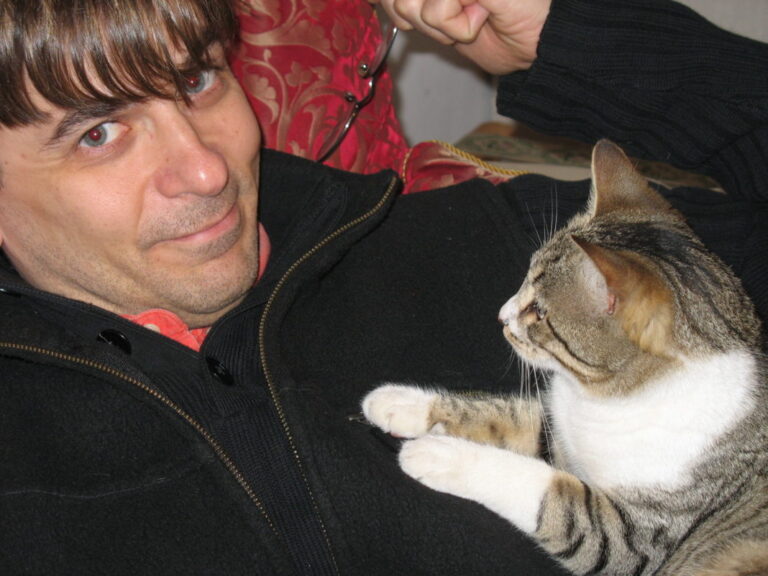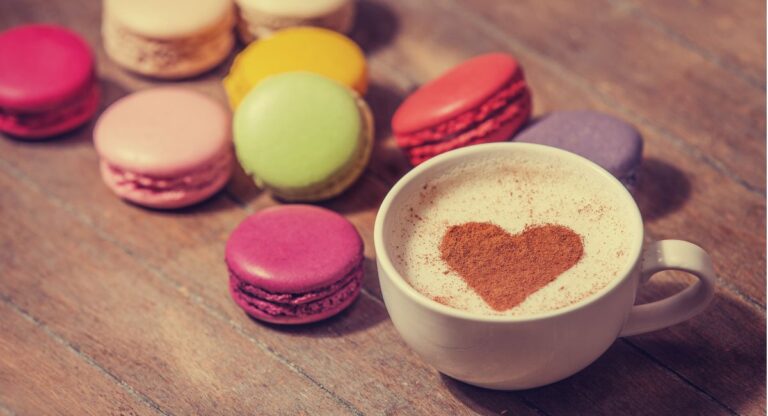Before we moved to France, I had no interest in rummage sales. Every weekend in our Portland neighborhood there always seemed to be some pitiable display of wares arranged in someone’s driveway: Moldy paperbacks, limp cardigans sagging from old metal hangers, a scuffed baby car seat, a coffee table with battered legs, an ironic pole lamp that would probably electrocute you, the ubiquitous NordicTrack. Once, when my daughter was little, we walked past a garage sale and she said, “Why would anyone want anyone else’s junk?” which proved that even though she looked exactly like her father, she carried my suspicion of second-hand sales deep in her DNA.
Then I moved to Collioure and was introduced to the vide-grenier. Literally translated as “attic emptier,” it more loosely refers to any rummage sale/flea market/swap meet/antique fair. The vendors are people who’ve literally emptied their attics (or more likely the attic of some ancient relative who has passed), and brocanteurs, antique dealers. Every spring and every fall in every village there is a vide grenier. At “vide-greniers.org” you can find any vide grenier in the entire country of France. I was intrigued – the junk of France, like pretty much everything else about France, is certainly sexier. But it was going to take a lot to overcome my lack of enthusiasm for such events.
Enter my friend, Peta. She is English and South African and lives a few houses down on the rue. She is one of those women with excellent gray hair, who can swipe on some red lipstick, toss on a white linen frock, and rival any Parisienne for devastating chic. And that white linen frock? It’s agnès b. and she paid two euros for it at a vide grenier.
Late last spring, on an unseasonably hot day, we left at 9:00 am for the big vide grenier at Laroque-des-Alberes. Laroque is known for attracting people of wealth and taste, and, as a result, their cast-offs are extra desirable. Peta is a vide grenier pro. She made sure we had our big woven paniers, water bottles, sunscreen, and a big Ziploc bag of one-and-two-euro coins.
She also had a method of attack. You must go up and down the aisles, looking only at what is directly in front of you. No drifting across the aisle; she calls it “going off piste.” She knows the difference between genuine and faux vintage. She is not afraid to dive into a pile of dubious-looking table linens and dish towels, confident she will find the one incomparable piece of French linen to be had. For which she will pay one euro. To spend a day at a vide-grenier with Peta is to wonder why you would ever buy anything new.
If you’ve been reading this column for any length of time, you probably have developed a bit of a crush on my husband, Jerrod. He’s quirky, funny, resourceful, and pretty cute. However, he’s also a smoker. Not only is he a smoker, but he is the worst kind of smoker, the kind who believes he isn’t a smoker because he only smokes during social occasions. There was some legitimacy to his delusion when we lived in Portland, because we didn’t have much of a social life. Our social occasions, such as they were, consisted mostly of literary events, where there was no smoking. When we would have dinner at someone’s home, usually no one else smoked, and Jerrod could more easily fight the urge.
France, on the other hand, is smoker heaven. People puff away without apology here, and every time anyone sits down to have something to drink or eat with someone else it qualifies as a social occasion. That Jerrod is the most sought-after guest on the rue guarantees that every other day he’s engaging in a social occasion with other smokers. As everyone knows (and yet it bears repeating): the more you smoke the more you smoke. Your three cigarettes a day become five cigarettes a day become seven, and pretty soon you’re sneaking outside, alone, to have a cigarette, no other smoker or social occasion in sight. This is what’s happened to Jerrod.
As a life-long non-smoker, I’m against it. As the daughter of a father who died of lung cancer, I’m against it. As a writer and only child who took care of her father as he was dying, and was so shaken by the experience she wrote a book about it, I’m against it. And yet, you can only whine, “I wish you’d stop smoking” so many times. You can only fume ,”If you loved me, you’d stop smoking!” so many times. You can only threaten, “If you get lung cancer, I am putting you into a shopping cart and leaving you under a bridge!” so many times. Quitting smoking was a decision Jerrod would have to make for himself. And anyway, eventually, I just couldn’t stand hearing my own nagging. So I stopped. Nagging, that is.
It should also be noted that French non-smokers, for the most part, don’t rag on their smoker spouses and partners. Instead, they shrug and say, essentially, “Bof! If that’s the way they want to kill themselves, then who am I to stop them?” My non-smoking friends ask me whether it drives me crazy. Of course it does. I hate it. But am I supposed to divorce him over his smoking?
I had already adopted the Gallic shrug in relation to Jerrod’s smoking when Peta took me to the Laroque vide grenier. It was held in a huge field, with a make-shift snack bar at the back where you could buy grilled sausages and frites. I was happy enough to wander behind her and passively admire the things she admired — the English white ware jugs, and antique christening gowns and nineteenth century tea tins. At her suggestion I forked over four euros for twenty-four restaurant grade wine glasses, but I was only moderately engaged.
Then I found The Ashtray. It was arranged on a long table among mugs, pitchers, glasses, a stack of old magazines, a box of black-and-white postcards. It was rectangular in shape, a milky French blue, with Gauloises Longue embossed on the wide lip. It was a perfect specimen of the kind of French advertising ashtray that was all the rage in the 50s and 60s. I could balance it on my palm. It was simple and beautiful. I stood in the middle of the aisle, blocking traffic. I turned it over and over, the ceramic finish smooth in my hands. The heft of it possessed authority.
I’m not much given to sentimentality, but this ashtray summoned my childhood like some magical portkey straight from Harry Potter. I whooshed back to the deep past, when I was a small child living in Whittier, California with my parents. It was the 1960s. It was sunny all the time, and my parents hosted cocktail parties around our kidney-shaped swimming pool. They hosted Halloween costume parties, Fourth of July and Labor Day barbecues. At these parties, they drank and smoked their heads off. As dedicated partiers of the era, they naturally possessed a collection of fabulous ashtrays. One was made of orange glass. It was huge and square, heavy enough that my mother kept it at her bedside when my dad was away on business, to use as a weapon in the unlikely event of an intruder. They owned another ashtray that was amoeba-shaped, with tiny bubbles suspended in the deep green-colored glass. Its edges turned in on themselves, like a sea creature under threat. They were works of art, these ashtrays, from a time when no one was ashamed of smoking, or all the other terrible habits they had that would eventually do them in.
When I showed Peta the Gauloises ashtray, she took it from my hand and purchased it for me. At five euros, it was a splurge. She told me that there are a lot of vintage ashtrays to be found at vide-greniers. You just have to search. And just like that, I fell in love with vide greniers.
I gave the ashtray to Jerrod. I suppose I could have put it on my desk and used it to hold paperclips, but it occurred to me that if Jerrod was going to smoke, it was stupid to pretend he didn’t. I said, “Isn’t this beautiful? It’s for you. There’s no reason to use a shitty old jam jar for an ashtray. You’re going to use a proper, grown-up, beautiful object. THIS.”
“Cool,” he said. He was suspicious. He was waiting for the other shoe to drop, waiting for me to nag him to stop. But my nagging had done no good. There was no other shoe, only another ashtray, from next weekend’s expedition. (This one was Van Gogh yellow and reminded me of a speed boat.)
The vide-grenier was no longer an event that reminded me of sad rummage sales. Instead, it was a weekend foray that was alive with possibility, where I might find interesting objects – like vintage ashtrays. Who could have predicted such a thing? That ashtrays would be the madeleines that connected me to my father and memories I hadn’t recalled in decades. Soon, in short order, after several months and a handful of vide-greniers, we had more ashtrays than Jerrod could ever need. When all our French friends came for an apéro, every smoker had their own. I had placed them all around my outside terrace.
Then, this fall, we both got Covid. And suddenly, Jerrod had no choice but to quit. The vice-grip headache, the unspeakable fatigue, the insistent cough. For two weeks, he didn’t smoke. Once we recovered, I mentioned that this might be a great time to truly give it up. He’d already been through the worst of it! He already had a head start! And he agreed. Just like that. He has now repurposed the milky blue ceramic Gauloises ashtray as a holder of tiny computer screws, the kind he always loses. Cigarettes are poison, but a beautiful vintage ashtray, like true love, is a thing of joy forever.
Karen Karbo is a frequent contributor to Frenchly. Her 2021 essay, Au Revoir Thanksgiving, was the germ for this column, Rue du Soleil. Karen is the author of fourteen award-winning novels and works of non-fiction, including the international bestseller, The Gospel According to Coco Chanel. Her essays, articles and reviews have appeared in Elle, Vogue, O., The New York Times, Tin House, Salon, Slate and elsewhere. To connect with her, buy her books, and learn about her writer’s retreat in Collioure, please visit her website here.
Photo credit, Karen Karbo.







